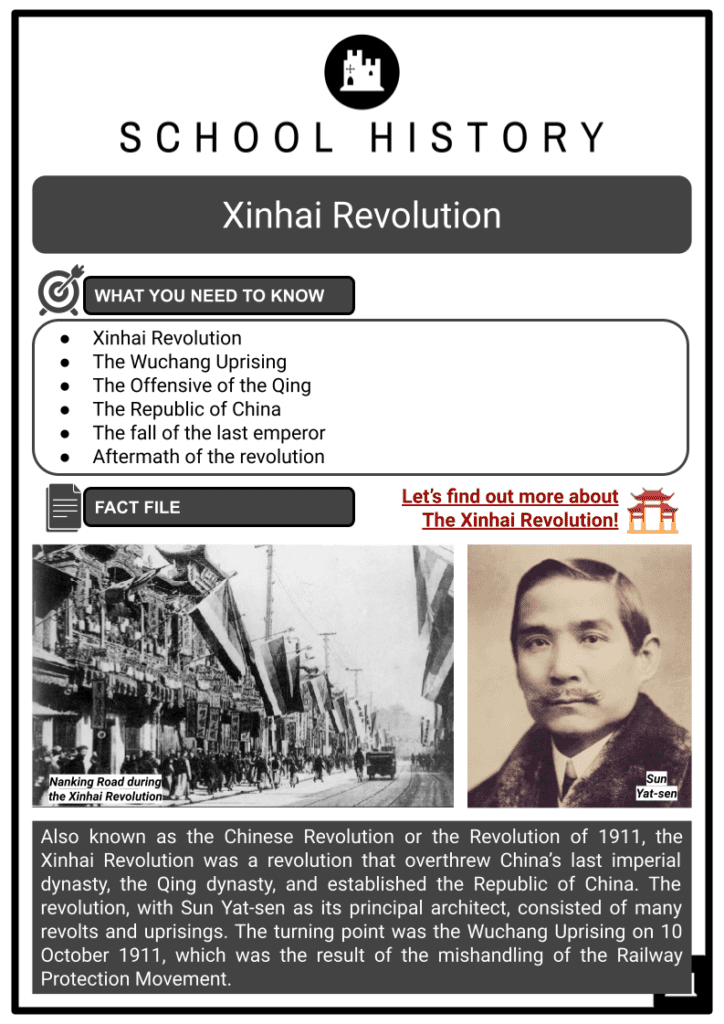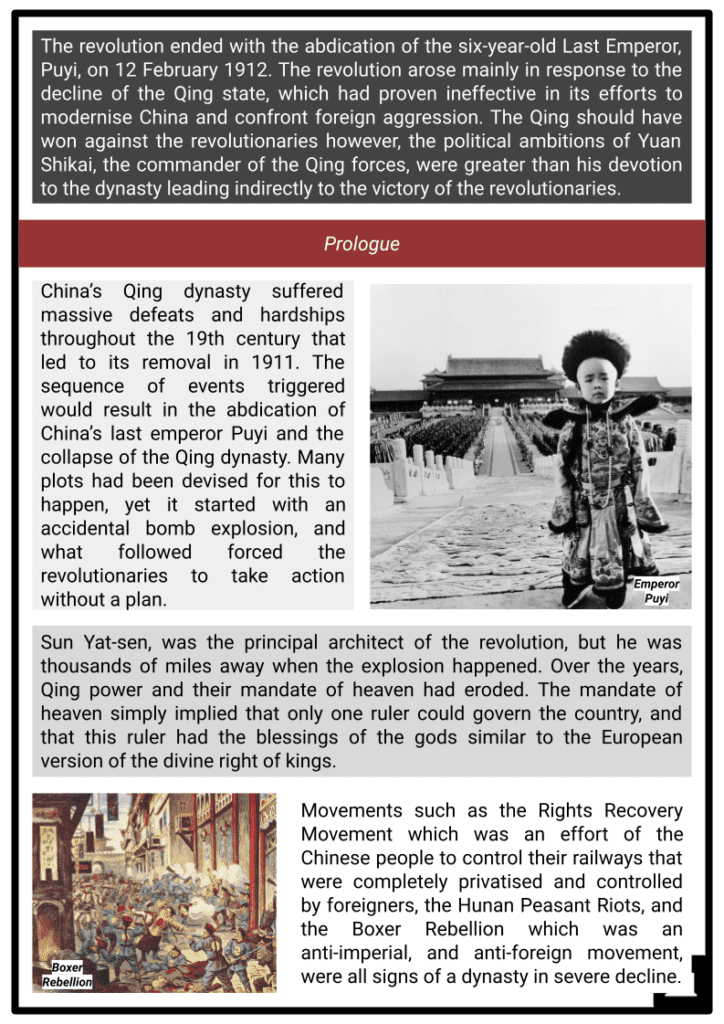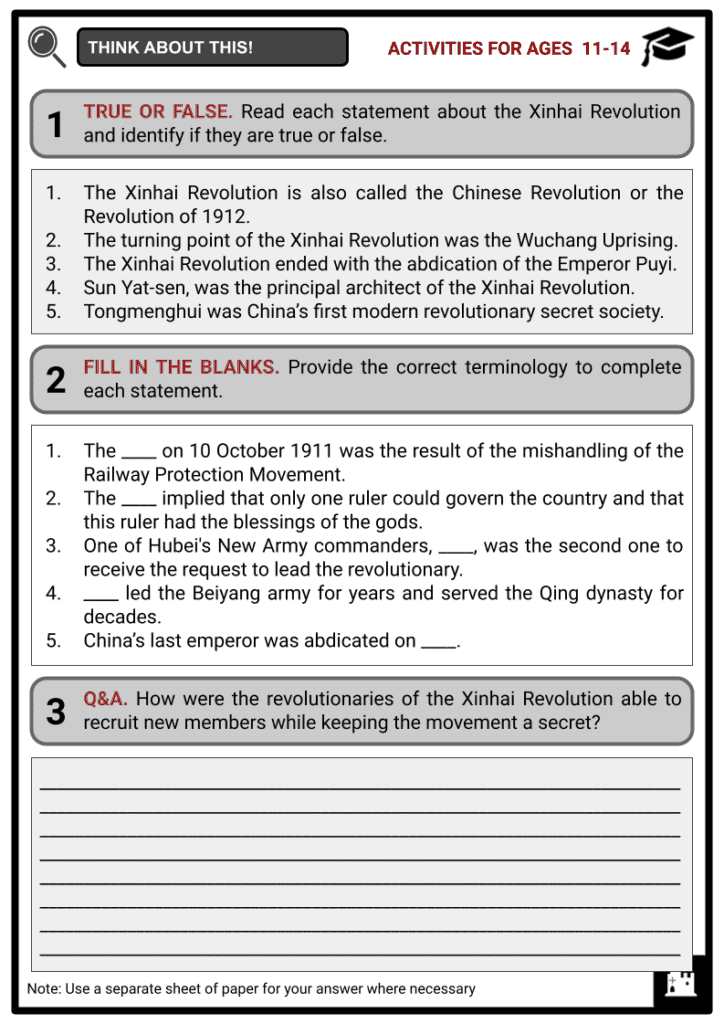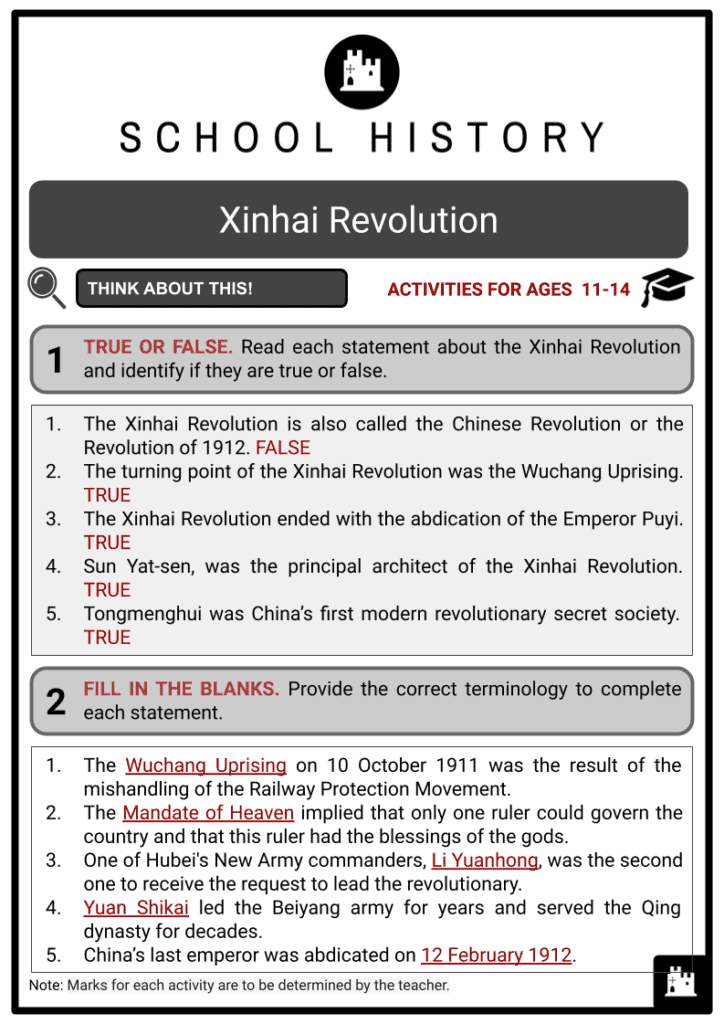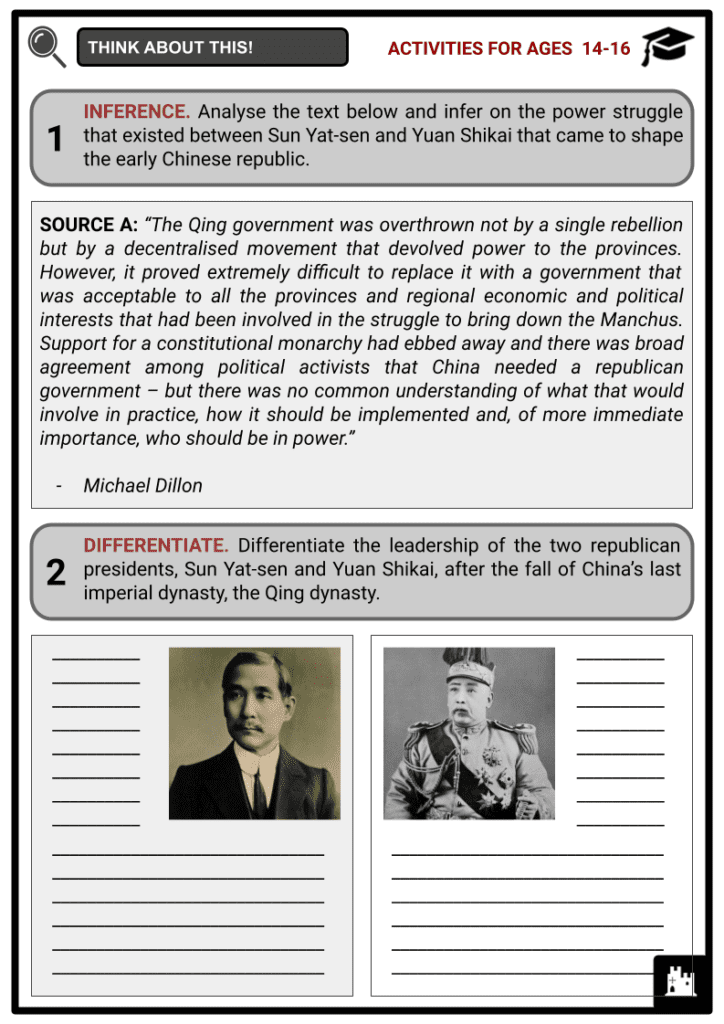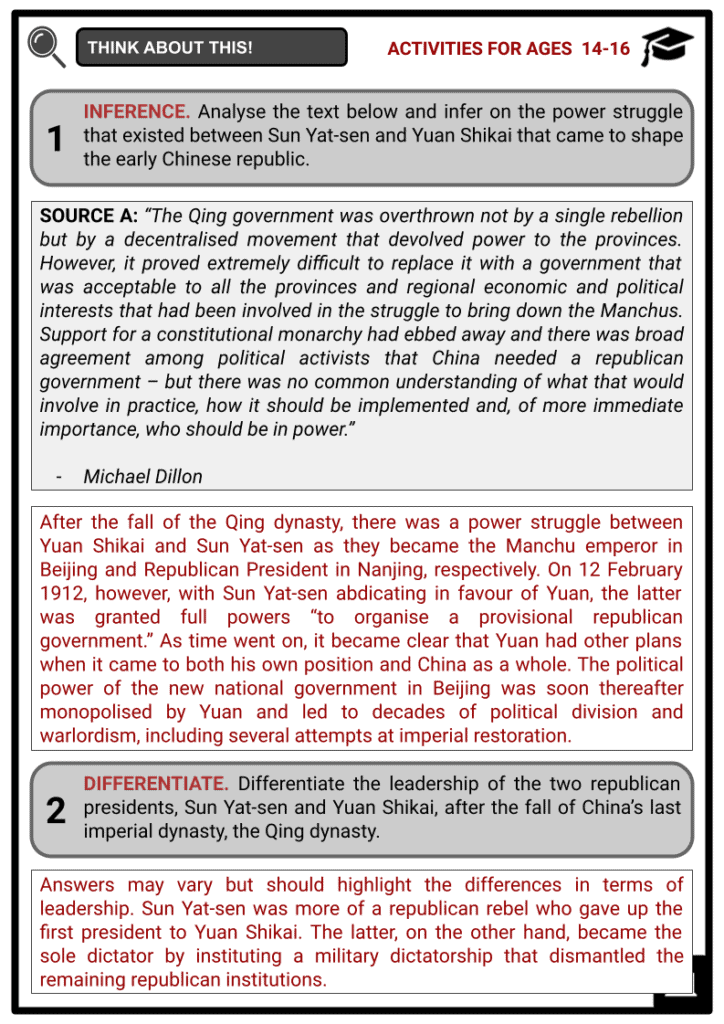Download Xinhai Revolution Worksheets
Do you want to save dozens of hours in time? Get your evenings and weekends back? Be able to teach about Xinhai Revolution to your students?
Our worksheet bundle includes a fact file and printable worksheets and student activities. Perfect for both the classroom and homeschooling!
Table of Contents
Add a header to begin generating the table of contents
Summary
- Xinhai Revolution
- The Wuchang Uprising
- The Offensive of the Qing
- The Republic of China
- The fall of the last emperor
- Aftermath of the revolution
Key Facts And Information
Let’s know more about the Xinhai Revolution!
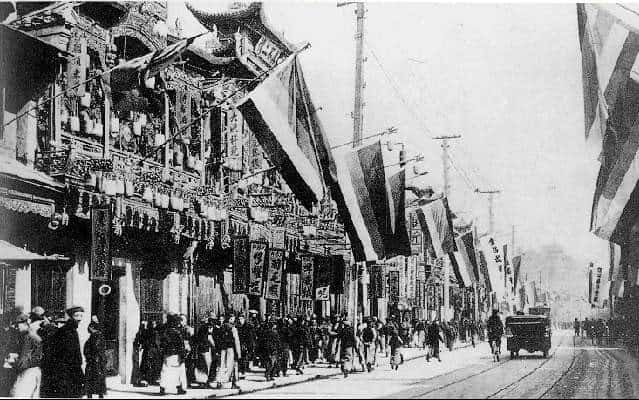
- Also known as the Chinese Revolution or the Revolution of 1911, the Xinhai Revolution was a revolution that overthrew China’s last imperial dynasty, the Qing dynasty, and established the Republic of China. The revolution, with Sun Yat-sen as its principal architect, consisted of many revolts and uprisings. The turning point was the Wuchang Uprising on 10 October 1911, which was the result of the mishandling of the Railway Protection Movement.
- The revolution ended with the abdication of the six-year-old Last Emperor, Puyi, on 12 February 1912. The revolution arose mainly in response to the decline of the Qing state, which had proven ineffective in its efforts to modernise China and confront foreign aggression. The Qing should have won against the revolutionaries however, the political ambitions of Yuan Shikai, the commander of the Qing forces, were greater than his devotion to the dynasty leading indirectly to the victory of the revolutionaries.
- Prologue
- China’s Qing dynasty suffered massive defeats and hardships throughout the 19th century that led to its removal in 1911. The sequence of events triggered would result in the abdication of China’s last emperor Puyi and the collapse of the Qing dynasty. Many plots had been devised for this to happen, yet it started with an accidental bomb explosion, and what followed forced the revolutionaries to take action without a plan.
- Sun Yat-sen, was the principal architect of the revolution, but he was thousands of miles away when the explosion happened. Over the years, Qing power and their mandate of heaven had eroded. The mandate of heaven simply implied that only one ruler could govern the country, and that this ruler had the blessings of the gods similar to the European version of the divine right of kings.
- Movements such as the Rights Recovery Movement which was an effort of the Chinese people to control their railways that were completely privatised and controlled by foreigners, the Hunan Peasant Riots, and the Boxer Rebellion which was an anti-imperial, and anti-foreign movement, were all signs of a dynasty in severe decline.
- China suffered around 285 uprisings and rebellions during 1910, the majority of which were sparked by peasants who did not have a clear vision of what they wanted or ideological basis. However, there was one modern revolutionary movement attempting to overthrow the Qing: the Revolutionary Alliance or Tongmenghui.
- Dr. Sun Yat-sen was the founder of the Tongmenghui, China’s first modern revolutionary secret society. Although he instigated 10 rebellions between 1906 and 1911, all of these were vaguely planned and none succeeded.
- Nevertheless, the number of members of the Tongmenghui rose to 10,000 by 1911. Its members were from all walks of life but, generally, they were educated Chinese that had studied abroad, mostly in Japan. Some revolutionaries were students while others were civil servants, members of the new provincial assembly even, and several others were soldiers or officers in the New Army units.
- Many revolutionaries figured that the best way to eventually spark a revolution was to infiltrate and convert Qing troops.
- They wanted to get the soldiers that weren’t yet revolutionaries on their side. As such, revolutionaries joined the army, maintaining a low profile and recruiting other soldiers for their revolutionary cells. Throughout China, especially around Wuchang, Hanyang, and Hankou districts in Wuhan, Hubei’s capital, Qing opposition blossomed. Radical young Chinese formed revolutionary cells in these big cities.
Xinhai Revolution
- In 1911, big cities generally had multiple revolutionary cells. It was during this year that Sun Yat-sen embarked on a fundraising campaign to the United States. The revolution desperately needed funds if it was to succeed.
- In southern China, the strategy of infiltrating the New Army units was adopted. Working with revolutionary branches active in the region, most cities had a sizable portion of their army secretly engaged in revolutionary activity, which led to a very unstable combination.
- In order to recruit new members for their movement, these revolutionaries often created an elaborate guise of book-clubs and fraternities to throw off suspicious eyes. If the authorities indeed grew suspicious of these clubs and decided to investigate, they would simply disband their fake clubs only to regroup under a different name after some time at a different location.
- In 1911, around 5,000-6,000 of the Hubei’s New Army troops turned out to be members of various secret revolutionary societies. This was about one-third of the total military force.
Wuchang Uprising
- On 9 October 1911, a group of revolutionaries were fiddling with bombs in their safe house. This was located in the Russian concession area of Hankou. They were planning a terrorist attack but something went wrong and the bomb exploded prematurely.
- While the Western powers would often bribe Qing authorities if something happened on their territory, the blast of the bomb was too heavy not to let authorities investigate. The safe house was raided by Qing police and military. It quickly became clear what transpired, and the three men that had survived the blast were identified as revolutionaries and were executed.
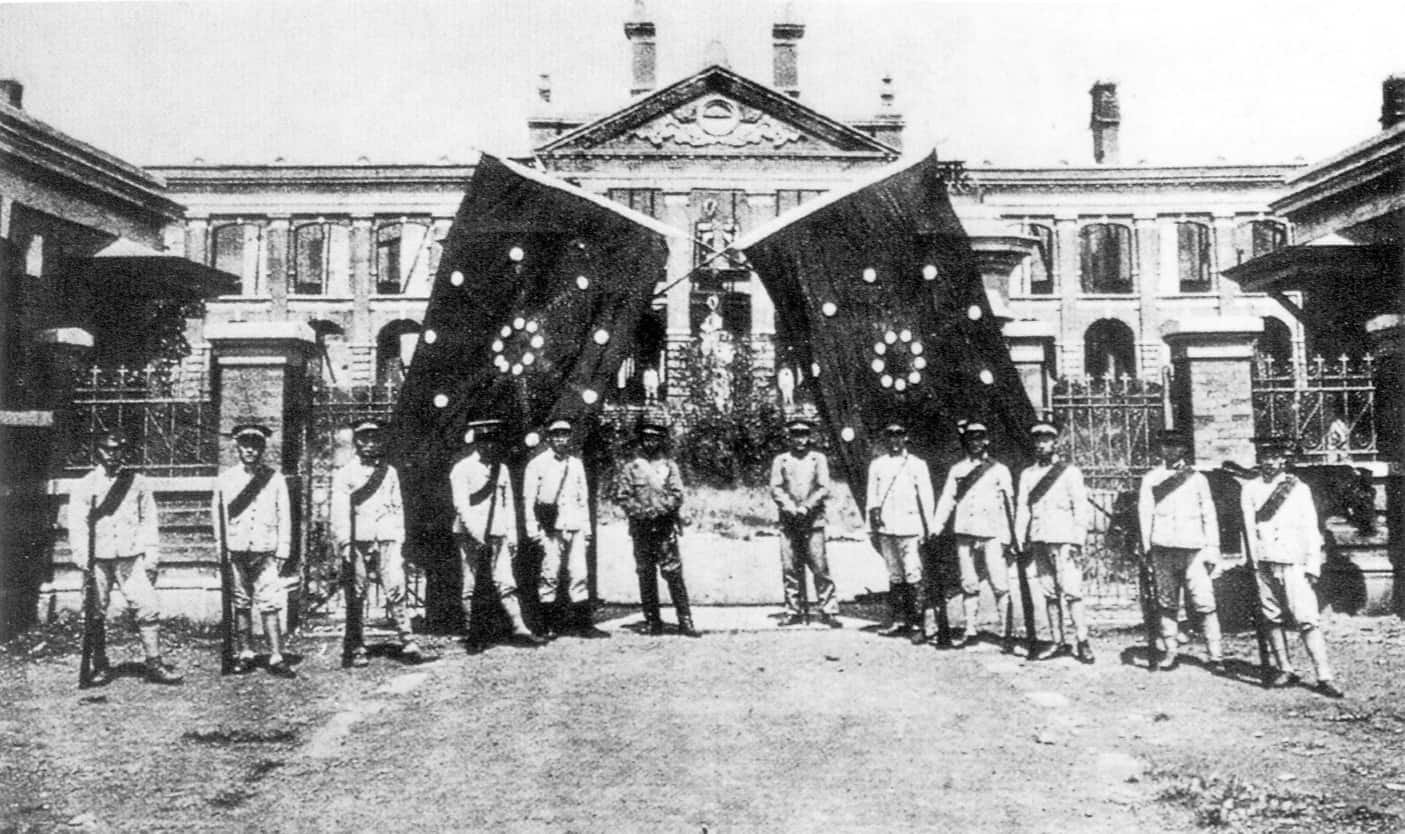
- The membership registers in which all names of revolutionaries were written, thousands of them, surprisingly survived the blast. The Qing authorities seized these registers and now possessed the names of most if not all revolutionaries in the city; on this list, many names were that of their colleagues.
- Alarmed at the number of soldiers on the list, soldiers began rounding up all revolutionary soldiers they could find. Soldiers that were members of the secret society understood that if they did not react fast, they too would be put against the wall soon.
- The first force that mutinied was a small force, the Wuchang Eight Engineer Battalion. On the morning of 10 October, ever since celebrated as “Double Ten Day”, they seized the ammunition deposits of the city and were subsequently joined by transport and artillery units.
- Wunchang’s forts were captured and by the end of the day, three other regiments joined the resistance. After failed attempts to raise a sizable amount of loyal troops to protect his office, the governor-general Ruicheng, a Manchu, fled the city together with the army commander.
- Forces that were still loyal to Qing were routed and over 500 were killed. The next day, on 11 October, Hanyang was captured by the revolutionaries and its military arsenal and ironworks were seized. It was after the capture of Hanyang that the mutineers established the military government of Hubei yet they didn’t have a known public figure to take control and lead the revolution.
- The principal architect of the revolution in China, Sun Yat-sen, was in the United States gathering funds for the revolution. He would not learn about the revolution until a month later, reading about it in the newspapers. When he did, instead of quickly returning to China and assuming leadership of the revolution, he first went to the United Kingdom and France, in order to secure European neutrality.
- He managed to sway the British government to not loan any money to the Qing anymore. Sun Yat-sen eventually returned to China, but only 2 months after the revolution had started. In October, the revolution confined to Wuhan was still looking for its leader. The first person the revolutionaries approached was the president of the provincial assembly who declined the offer.
- One of Hubei's New Army commanders, popular amongst his troops, Li Yuanhong, was the second one to receive the request. He wasn’t a revolutionary, but had played a prominent role during the railway controversy against the Qing, and was liked by those in the provincial assembly. He hesitantly accepted the offer of the revolutionaries. The next day, Hankou troops also mutinied, captured the city, and the revolutionaries were on their way to capture the rest of the province.
The Offensive of the Qing
- Once the imperial government found out about what was going on in their Hubei province, they did everything in their power to annihilate the revolutionaries. The minister of war, Yinchang, coordinated the counterattack on Wuhan with two divisions of the Beiyang army. In Beijing, the Qing and especially Prince Chun, regent to the 5-year old emperor Puyi, was about to swallow his pride.
- The Beiyang army needed a competent general that was known by senior officers and respected by his troops. Yuan Shikai was that person. He had led the Beiyang army for years and served the Qing dynasty for decades. But prior to this, Prince Chun forced Yuan into retirement 2 years before, and Yuan still held a grudge against the Qing because of it.
- While he held a grudge, he was an excellent negotiator and unbeknownst to the Qing, he was ambitious and had his own agenda. For now, he waited, but when he finally gave in, he would come to power on his own terms. After 10 days of the Hubei’s military government being proclaimed, in both Shaanxi and Hunan province, the New Army mutinied. Massacres against the Manchu population took place and Qing commanders were killed. The members of the provincial assembly for the provinces explicitly voiced their support for the revolution.
- The uprising now spread over China at a fast pace: In Shanxi, the governor and his family were killed. In the southwest in Yunnan and southeast in Jianxi, students, teachers, and merchants joined the army officers in revolt, declaring their independence from the Qing as well. The Tongmenghui took the central leading role upon itself in three provinces and formed anti-Qing alliances in many other provinces. Now that more provinces were swept by revolts, the military significance of the railways became apparent. Troops from Beijing were sent to Wuhan, only to be cut off by rebellions from Shanxi.
- The supply lines of Yinchang’s army were blocked and other senior commanders in the north started defying Qing orders. Instead of moving their troops south by rail, these commanders now met up and sent a telegram to Beijing containing 12 demands.
- The demands ranged from a functioning parliament and elected prime minister, ratified by the emperor, to amnesty for all political offenders and blocking Manchus from obtaining official positions.
- The fact that the Qing agreed with these demands within a week, showed the dire situation the dynasty was in. During this time, Yuan was still negotiating both publicly and secretly on various levels. The Qing appointed him as the commander of all Qing forces. He was backed by most senior military commanders, enjoyed the loyalty of many troops and on 8 November 1911, he was elected prime minister of China by members of the Beijing provisional national assembly.
- He formed a cabinet, primarily appointing his loyalists. It seemed that China was moving towards a constitutional monarchy just like Russia and Japan had. The entire month of November, Yuan Shikai played a political game, pressuring both the revolutionaries and the Qing, attempting to get the most profit out of the whole situation.
The Republic of China
- The Tongmenghui of Sun Yat-sen enjoyed an enormous amount of support among the Chinese. Nanking was captured by the revolutionaries in early December. It was the second biggest city of China, and the former capital, the symbolic defeat was crushing to the already weak Qing. It was reminiscent of Prince Fu’s defeat in 1645, and of course, the capture of the city by Taiping rebels under Hong Xiuquan in 1853 during the Taiping Rebellion.
- In Nanking, the Tongmenghui set up its provisional government. In the meantime, Yuan negotiated primarily with Prince Chun, regent of Puyi, and his consorts. In December, the mother of Puyi took a leading role in the negotiations. She pushed for the resignation of Prince Chun and authorised Yuan Shikai to rule as prime minister, with the emperor, her son Puyi, only retaining a ceremonial role.
- It was reminiscent of the role Empress Dowager Cixi had allocated to herself the past decades and thus, not very popular.
- Several victories of Yuan’s troops over the revolutionaries followed but he realised that with the suppression of the revolution, his usefulness to the Qing would once again fade. On Christmas day 1911, Sun Yat-sen arrived in Shanghai. The Tongmenghui had set up a provisional government at Nanjing and Sun Yat-sen was just in time to be elected “provisional president” of the Chinese republic by delegates from 16 provincial assemblies.
- On New Year’s Day 1912, he assumed office, and the new Republic of China was born. However, this meant that China now had both a Manchu emperor in Beijing and a republican president in Nanjing. Sun Yat-sen realised he needed an army to consolidate his power.
- A charismatic man and with a keen eye for political moves, he sent Yuan Shikai a telegram stating he only accepted the provisional presidency, so Yuan could, later on, assume the official presidency, as long as he supported the new republic.
- All the while Yuan had been playing both sides of the conflict and he now realised choosing the revolutionary side was probably going to be the most advantageous to him. As such, Yuan was willing to work with Sun, but only if he could assume the presidency. He spent the next couple of weeks negotiating both publicly and secretly, with both the provisional government in Nanking and the imperial government in Beijing.
The Last Emperor Falls
- Near the end of January 1912, 44 senior commanders of the Beiyang Army, serving under Yuan Shikai, sent a telegram to Beijing urging them to create a republic. The Qing’s mandate of heaven had now truly waned. Southern China had basically seceded, and Yuan Shikai now attempted to convince Puyi’s regents that abdication was the only option left on the table.
- Many Manchurians fled to Manchuria to lead the resistance against these demands, but the emperor’s mother negotiated with Yuan and settled the issue. She managed to receive reassurance that Puyi could reside in the Forbidden City with his servants for years to come, and a generous sum to be sent to him.
The Last Emperor Falls
- Puyi, China’s last emperor, was abdicated on 12 February 1912. The Qing dynasty, the ancient monarchy, and the Chinese empire had officially come to an end. Yuan Shikai was granted full powers “to organise a provisional republican government.” Sun Yat-sen, staying true to his word, abdicated in favour of Yuan one day later. The deal was that Yuan would travel to Nanjing to set up his government, but unrest broke out in Beijing which allowed Yuan to remain in Beijing in order to keep control. It is near certain that Yuan had something to do with these episodes of unrest. And as such, ominously, Yuan Shikai was sworn in in Beijing, the imperial capital, not Nanjing, the republican capital.
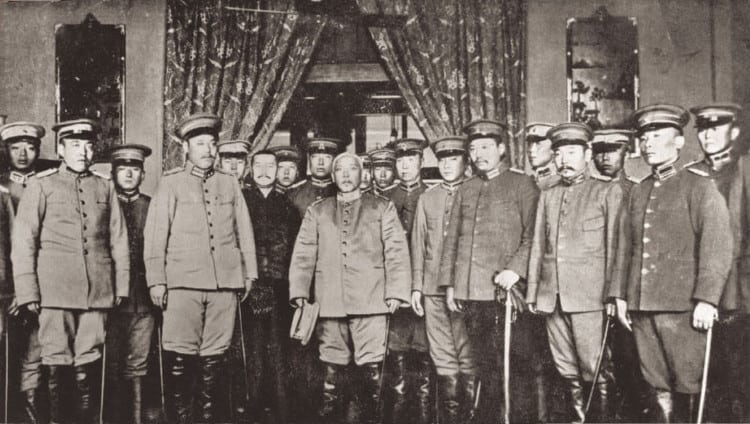
- He was to have supreme power with loyalists appointed in crucial positions in China’s military and bureaucracy. A parliament was to be elected and a fully constitutional government was going to be established.
- As time went on, however, it became clear that Yuan Shikai had other plans when it came to both his own position and China as a whole. The political power of the new national government in Beijing was soon thereafter monopolised by Yuan and led to decades of political division and warlordism, including several attempts at imperial restoration.

